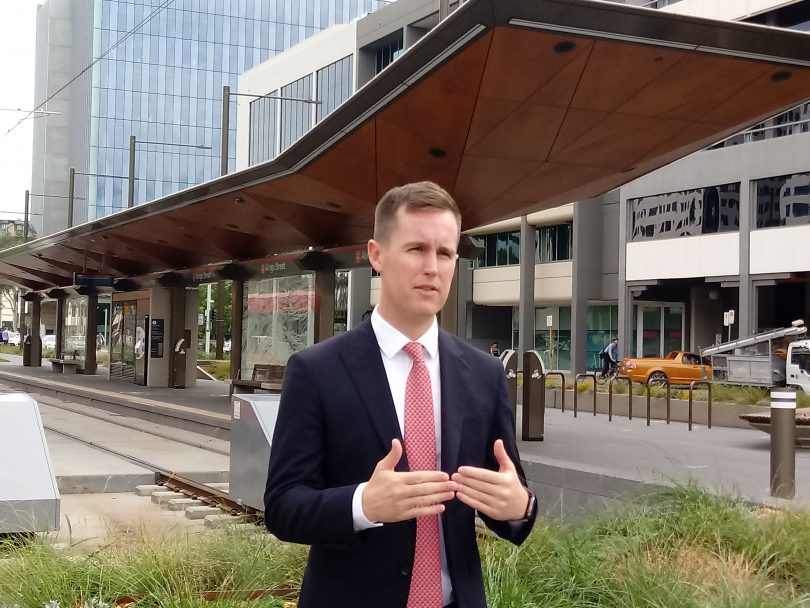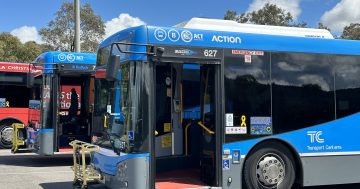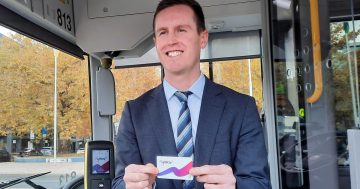
Shadow Minister for Transport Mark Parton called on the government to report on the risks facing the light rail fleet. Photo: Damien Larkins.
The ACT Government has moved to quell concerns that the ACT’s light rail vehicles (LRVs) could experience cracking similar to that experienced in Sydney’s fleet.
Last month, cracks were discovered in 12 light rail vehicles in Sydney, all of which were the same model the ACT uses, leading to the inner-west light rail service being decommissioned for 18 months.
Cracking has also been identified in LRVs in Belgrade, Serbia, France and the UK.
This prompted Shadow Minister for Transport Mark Parton to call for the government to report on the risks facing Canberra’s light rail and provide contingency plans in case any similar cracking does occur.
Minister for Transport and City Services Chris Steel told the Assembly on Wednesday (10 November) that following information from Sydney, the ACT’s light rail operator, Canberra Metro, and manufacturer CAF had undertaken inspections of the vehicles and had not detected any cracking to date.

Minister for Transport Chris Steel says there’s nothing to worry about with Canberra’s light rail fleet. Photo: File.
While Mr Steel said inspections for cracking would be ongoing alongside usual maintenance, he also listed a number of ways in which Canberra’s light rail is different to Sydney’s.
For example, the ACT’s system operates on a different track and has differences in its operating profile in terms of geometry and vibration and braking and speed, he said.
“The Canberra fleet is also significantly younger than the Sydney fleet, with the LRVs only having travelled 190,000 kilometres,” Mr Steel said. In comparison, Sydney’s inner-west fleet has travelled between 350,000 and 500,000 kilometres.
Mr Steel also pointed out the national regulator had not yet detected any problems with this particular model.
A motion moved by Mr Parton calling on the government to report on any risks facing the light rail fleet and advise what contingency plans are in place passed with amendments from Mr Steel.
The ACT Government will now report back to the Assembly on the outcomes of safety inspections undertaken on the light rail fleet by the end of the year and will present its contingency plans in case any cracking occurs.
Mr Parton said his office had been examining the issue of cracking in wheel arches of these vehicles in other jurisdictions for some time even before the Sydney issue had arisen and that issues associated with the Urbos 3 vehicles date back to 2014, “well before” the ACT had purchased its fleet.
“I’ve sort of become a bit of a light rail nerd,” Mr Parton said.
He asked Mr Steel in a question without notice if the government intended to procure these same vehicles for the next stage of light rail.
On this, Mr Steel said this particular procurement process was currently underway, and any future light rail vehicles procured would meet the safety standards in place at the time.
Mr Parton also raised concerns about the weight of the battery packs, which will need to be installed for the light rail to operate in the parliamentary triangle in the future.
Again, Mr Steel said he was aware of the need for this matter to be addressed in the next procurement process and that it would be considered.
Mr Steel accused the “Canberra Liberals [of taking] any opportunity to attack light rail”.
Mr Parton has long been outspoken on the government’s light rail plan. Earlier this year, he said the construction and congestion associated with the next stage of the project will hurt local businesses.
Last month he tried to move a motion calling on the Assembly to establish another select committee to examine the next stage of light rail. This ultimately did not pass.
Original Article published by Lottie Twyford on The RiotACT.






